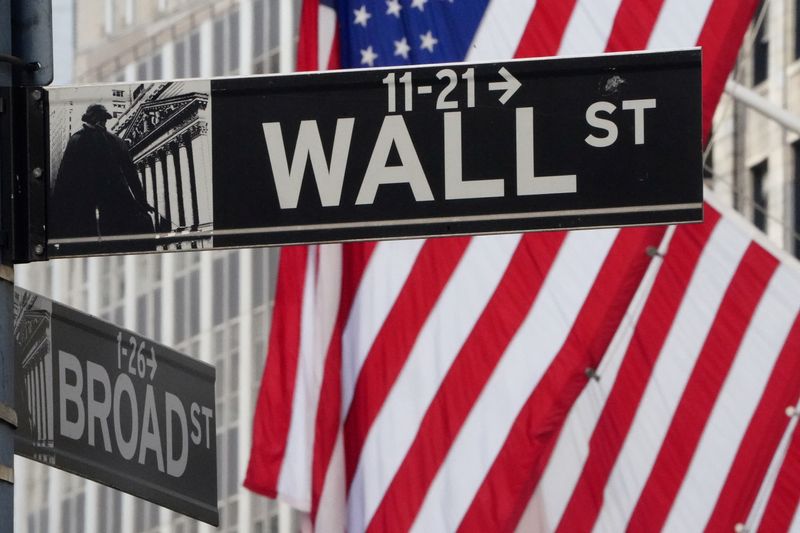By Michael S. Derby
NEW YORK (Reuters) – For a Federal Reserve that is actively weighing an end to aggressive rate hikes aimed at lowering inflation, easing financial conditions over recent weeks, on the face of it, appear more a foe than friend of monetary policy.
Since summer’s end, Goldman Sachs’ closely watched financial conditions index, a measure of financial market tightness, surged to its highest point of the year amid a huge rout in the Treasury bond market, only to ease aggressively at the end of October, returning the index to where it was on the last day of August.
That shift complicates the Fed’s narrative. Since the spring, policymakers have argued a broad tightening in financial conditions tied to their policy as well as banking sector stress was ginning up economic restraint and greasing the path back toward their 2% inflation target. That suggests looser financial conditions should make it harder to foster lower inflation.
But current and former Fed officials and a number of private sector economists say it isn’t that straightforward, arguing the evolution of financial conditions must be viewed over a longer horizon.
Moreover, some caution against focusing on broad indexes in favor of a more focused look at the real-world borrowing costs that can promote or hinder growth. On that front, things like home loan costs, access to credit and other borrowing are still stringent and likely to moderate activity.
How this might be affecting Fed thinking at its Dec. 12-13 policy meeting depends on how policymakers view both the rapid tightening of conditions and subsequent pullback.
William English, a former top Fed staffer who is now at Yale University, said that if the tighter financial conditions seen over part of the fall had persisted it might have affected forecasts for the economy. “But at this point,” with all that’s happened over recent months, “I assume this won’t have a consequence for the meeting coming up,” he said.
PERSISTENCE PUZZLE
The Fed, in its policy meeting concluding Wednesday, is almost certain to keep the federal funds rate where it’s been since July at between 5.25% and 5.5%. Markets, broadly convinced the Fed is done with rate hikes, have turned to betting on rate cuts. Chair Jerome Powell is sure to face questions on how the recent shift in financial conditions will factor in this outlook.
New York Fed President John Williams on Nov. 30 acknowledged both the tightening of financial conditions in part due to the increase in Treasury yields since summer and the more recent easing, noting that given volatility in financial markets he was taking a longer view.
“I would go back to the question that was always foremost in my mind, which was how persistent is this going to be,” he told reporters, adding recent market moves appear yoked to how much compensation investors are demanding to deal with uncertainty over the future.
Some economists reckon a focus on the year as a whole is the right formula for the Fed right now: Both Goldman’s index and the Fed’s own financial conditions index remain tighter than where they started the year, though one from the Chicago Fed suggests conditions are the loosest since the Fed kicked off its rate hikes in March 2022.
Matthew Luzzetti, economist with Deutsche Bank, noted the real – or inflation adjusted – 10-year Treasury yield often cited by Powell is below 2% now after surpassing 2.5% at the end of October. “During the summer it was 1.5% or 1.6%, so it is still, I think, meaningfully higher than it was over the summer months,” he said.
Analysts at Piper Sandler, however, said in a note the easing would be relevant to near-term monetary policy. “Much of the rationale for the Fed’s November skip has dissipated” with the recent drop in yields. From their perspective, “A December hike, one for the road, is far from off-the-table” to correct the shift in market pricing.
REAL WORLD RESTRAINT
One way bond market shifts have affected the real economy is by significantly boosting the cost of buying a home. From the start of 2021, when 30-year fixed-rate mortgages sported rates below 3%, they rocketed to just shy of 8% at the start of November, before retreating toward the current 7% mark.
That still-high level is “the punch line” to the financial conditions story, said Charles Evans, who retired from leading the Chicago Fed earlier this year. “When mortgage rates are 6, 7, 8 percent, that’s very meaningful for the path of the economy,” Evans said. Add to that the slower-moving rises in different corporate borrowing costs that are only catching up to much higher short-term rates, “you can see where eventually it hits,” and it’s not toward easier borrowing conditions.
Meanwhile, former St. Louis Fed leader James Bullard, now dean of Purdue University’s business school, said the Fed could have spared itself this headache by not referring to financial conditions in general terms. For one thing, he said broad indexes take in stock price shifts, which are something Fed officials typically don’t care much about.
What’s more, Bullard said for all the market moves, underlying interest rates tied to monetary policy remain quite restrictive, which should help keep market levels in line with what the Fed wants.
His current assessment of what constitutes tight policy would have the federal funds rate between 3.5% and 5.75%. With the current rate near the higher end of that range, he said, “I think that’s probably a good place to be if you’re trying to get inflation to come down pretty rapidly.”
(Reporting by Michael S. Derby; Editing by Dan Burns and Andrea Ricci)
